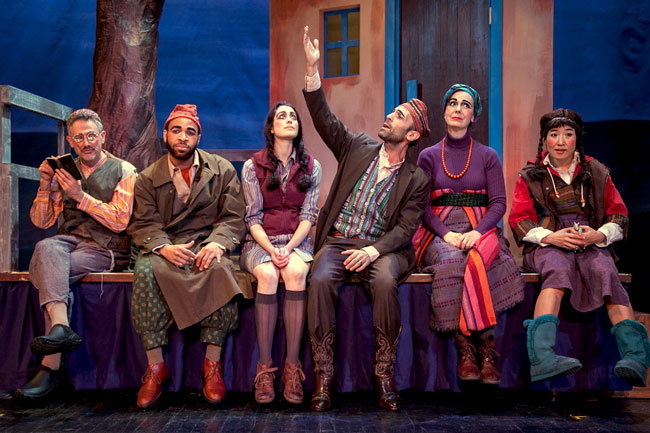
David Greenspan, Ugo Chukwu, Rachel Claire, Amir Darvish, Meg MacCary, & Susan Hyon ("Yiddish Theater for today's players and audience" - from the program notes)
Resembling Edith Sitwell's enormous rings, the colorful bosses were attached at the very top of raw wooden sticks tethered to each other at the ends of the outer seating sections inside the Abrons Art Center. The only thing clear was that the audience was not supposed to take those seats.
So what were those gorgeous, jewel-like ornaments all about?
I never found the answer. When the lights went up after Target Margin Theater's presentation of Peretz Hirschbein's "The ( * ) Inn", Barry and I were so affected by what we had just seen on the stage that neither of us thought to investigate. By the time we had engaged some of the production team in conversation moments later I had forgotten to ask for any enlightenment.
Thinking about it now, I may also have decided, unconsciously or not, to just go along with - can I say it? - the company's accustomed, and famously challenging obstruseness. Also, it's not impossible to imagine TMT's founder and the production's director, David Herskovits, merely wanting to keep the audience's experience intimate, by limiting its size.
The play (in English, although with some Yiddish elements), and the production, were both a revelation, but I also left the theater with a lot of questions, all of them, I think, far more interesting than why the paste jewelry?
Some of my questions relate to my passion for history and for Jewish culture, and some of them are more about how that history and culture relates to that of the ammei ha'aretzot.
I grew up in the Midwest, ignorant of Jewish anything.
I also grew up loving "The Goldbergs", first on radio, and then on TV, but I regret that I had little or no idea of the rich context of the drama of which Gertrude Berg was a part until decades later. I moved to New York in the mid-80's, but it was too late for the classic Yiddish theater scene on Second Avenue. Over the years, I sometimes overhear fragments of the little bit of Yiddish that survived the Holocaust, but it always makes me melancholy, and it made me still sadder that, even with a knowledge of German, I couldn't understand more.
Hirschbein's play was written over 100 years ago, but there are big surprises. Both in the original (as I understand from the program notes) and as adapted & directed by Herskovits for performance on the Lower East Side today it's a remarkable document of the almost-forgotten creativity of experimental Yiddish theater. The company's notes describe their collaboration:
The shtetl turns uncanny in Hirschbein's classic of Yiddish life. You might be expecting the farm life, the chicken-plucking and the arranged marriage, but not the S&M lust and the body-snatching wedding guests. The ( * ) Inn was an early touchstone for experimental theater in Yiddish, a sensation in Vilna, in London and in a 1917 New York production. This play is a perfect example of why we at TMT believe Yiddish drama is as innovative and challenging as any in the world. It's Tevye on drugs. Watch out.
"The ( * ) Inn" is a great treat as theater, as an eyeopener, and - almost uniquely - as pre-WWI expressionist drama which can be experienced live today. I can't say I know all of what Hirschbein and Herskovits mean. As with all good theater, I believe, they leave the audience wanting to know more.
And I still don't know what the ornaments strung along the aisle mean; I'll just imagine those jewels as "runway lights" for the gem being mounted on the boards off Grand Street this month, TMT's tribute to Yiddish theater and to "the Yiddish Maeterlinck".
[image is by Erik Carter, for Target Margin Theater]